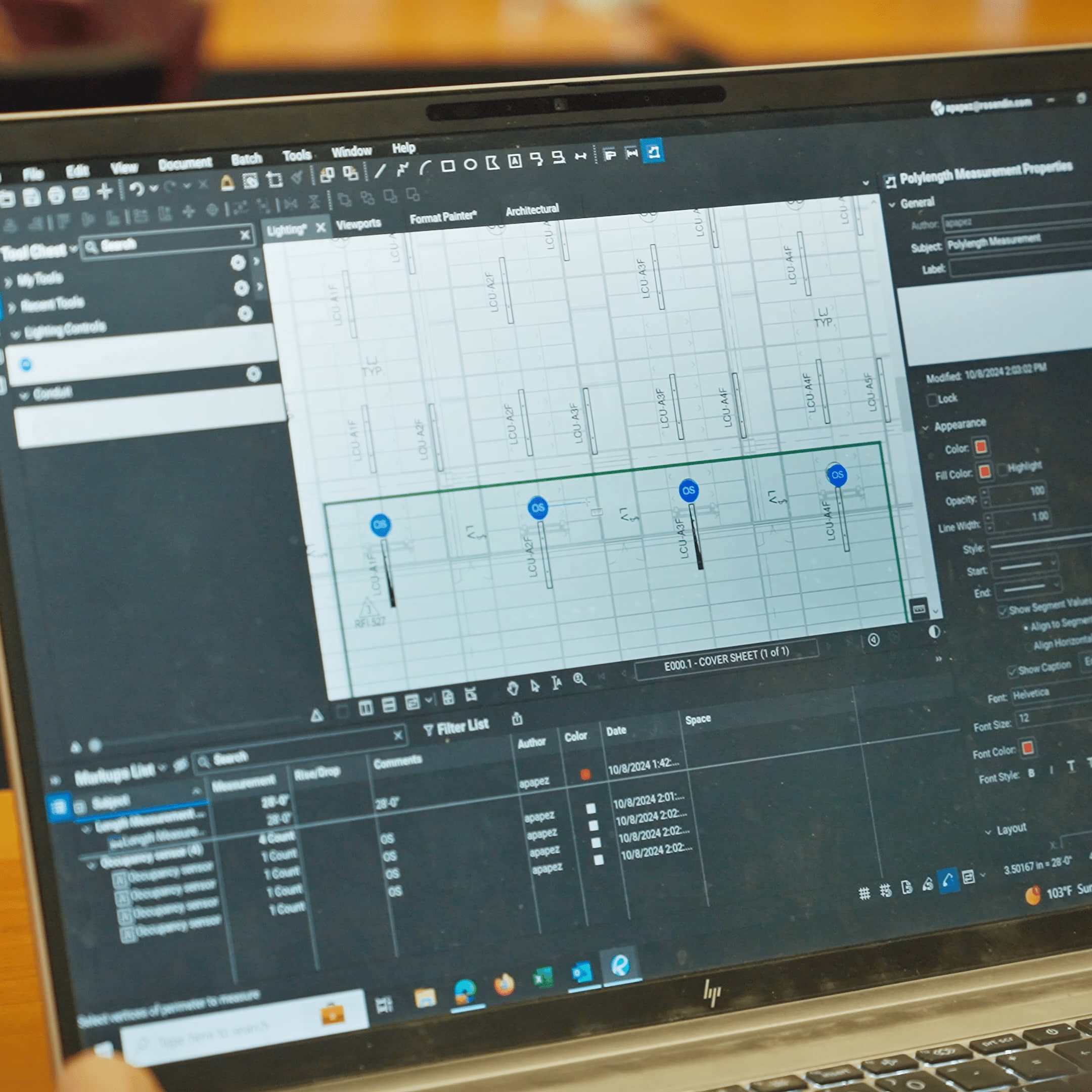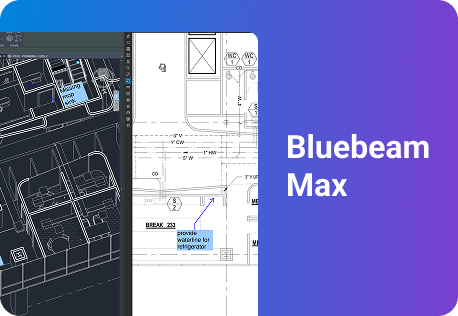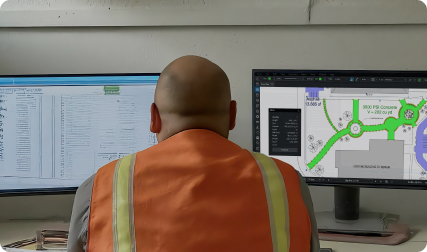Glossary of Terms
Explore this helpful glossary of commonly used terms in architecture, engineering, and construction.
No results found.
A
AC (Alternating Current)
Electrical current that reverses direction periodically, commonly used in buildings.
ACI (American Concrete Institute)
Organization that sets concrete construction standards.
ADA (Americans with Disabilities Act)
Law ensuring accessibility in construction for individuals with disabilities.
AISC (American Institute of Steel Construction)
Sets standards for structural steel construction.
As-built Drawings
Final set of drawings reflecting changes made during construction.
AutoCAD
Popular software for drafting and designing construction plans.
Abutment
Supporting structure at each end of a single span bridge. Types of abutments vary based on geotechnical, geographic, and constructability factors.
Architecture Software
Digital tools used by architects to design, visualize, and document building structures. These programs, such as AutoCAD, Revit, and ArchiCAD, help create 2D drawings, 3D models, and BIM (Building Information Modelling) designs, improving accuracy and collaboration in construction projects.
B
BIM (Building Information Modelling)
Digital representation of a building’s physical and functional characteristics.
Bluebeam
Leading construction software for AEC professionals to communicate clearly and work efficiently on project documents.
Blueprints
Technical drawings that outline a construction project’s design.
BOQ (Bill of Quantities)
Document listing materials, parts, and labor for a project.
Brick Veneer
A single layer of bricks used as an aesthetic covering rather than a load-bearing wall.
Buildability
How easily a design can be constructed efficiently and cost-effectively.
Building Code
Regulations that set safety, design, and construction requirements.
C
CAD (Computer-Aided Design)
Software used to create precise construction drawings.
Change Order
A document outlining changes to the original construction contract.
Cladding
Material used on the exterior of a building for protection and aesthetics.
CMU (Concrete Masonry Unit)
A precast concrete block used for building walls.
CO (Certificate of Occupancy)
Document confirming a building meets all codes and regulations.
Computational Design
The use of algorithms and computer processing to generate or optimize design solutions.
Construction Project Management Software
A digital tool that helps plan, coordinate, and manage construction projects by streamlining tasks like scheduling, budgeting, document management, and team communication.
Construction Management
Process of planning, coordinating, and overseeing a construction project.
Construction Management Software (CSM)
Software used in the process of planning, coordinating, and overseeing a construction project.
Construction Software
A digital tool that helps manage construction projects by streamlining tasks like planning, project management, collaboration, and communication.
Cost Estimation
The process of predicting the total expenses of a construction project.
Curing (Concrete)
The process of maintaining moisture in concrete to strengthen it.
Cut Sheet
A document detailing materials, equipment, or product specifications.
D
Design-Build
A project delivery method where design and construction are handled by one entity.
Drawing Set
A complete collection of construction drawings for a project.
Ductwork
System of pipes or channels that distribute air in HVAC systems.
Due Diligence
The process of evaluating risks before starting a project.
Drywall
A building material used for interior walls and ceilings.
E
Elevation Drawing
A two-dimensional side view of a building’s exterior or interior.
Energy Efficiency
Design and construction methods that reduce energy use.
Excavation
Process of removing soil and rock to prepare for construction.
Expansion Joint
A gap designed to allow movement in buildings due to temperature changes.
Erosion Control
Methods used to prevent soil erosion during construction.
Estimation Software
Software that helps contractors and estimators calculate project costs, including materials, labor, and overhead.
F
Facade
The front-facing exterior of a building.
Fasteners
Screws, bolts, nails, and other hardware used to join materials.
FEED (Front-End Engineering Design)
Initial project planning stage.
Field Report
A document recording construction site conditions and progress.
Footing
The base of a foundation that distributes load to the ground.
Formwork
Temporary structures used to mold concrete into a specific shape.
G
General Contractor (GC)
The main contractor responsible for overseeing a construction project.
Geotechnical Engineering
Study of soil and rock mechanics in construction.
Glazing
Installation of glass in windows and doors.
Grade Beam
A concrete support beam running along the ground to distribute structural loads.
Green Building
Sustainable construction practices that reduce environmental impact.
Greenfield Site
Undeveloped land used for agricultural purposes or left to evolve naturally, considered for urban development.
H
Hard Hat
Safety helmet worn on construction sites.
HVAC (Heating, Ventilation, and Air Conditioning)
Climate control systems in buildings.
Hydration (Concrete)
Chemical process where concrete hardens as it absorbs water.
I
IBC (International Building Code)
Standard building code followed in many regions.
Insulation
Material used to regulate temperature and sound in buildings.
ISO (International Organization for Standardization)
Sets global construction and engineering standards.
Interior Fit-Out
The final stage of construction where interiors are finished and equipped.
J
Joist
Horizontal structural element supporting floors or ceilings.
Junction Box
A protective enclosure for electrical connections.
K
Kickplate
A protective plate at the bottom of a door to prevent damage.
Kiln-Dried Wood
Wood dried in a kiln to reduce moisture content.
L
Lath
A framework used to support plaster or stucco.
Load-Bearing Wall
A wall that supports structural weight above it.
Logistics
The planning and coordination of materials, equipment, and workforce to ensure efficient construction project execution.
M
Markups
Digital annotations on construction drawings, often created using Bluebeam.
MEP (Mechanical, Electrical, Plumbing)
Key building systems.
Mortar
A mixture used to bond bricks or stones.
Modular Construction
Prefabricated sections assembled on-site.
N
Nailer
A strip of wood or metal for attaching panels or boards.
Non-Load-Bearing Wall
A wall that does not support any structural load.
O
OSHA (Occupational Safety and Health Administration)
U.S. agency setting construction safety standards.
Overhang
The part of a roof extending beyond the walls.
P
P&ID (Piping and Instrumentation Diagram)
Detailed diagram showing the interconnection of process equipment and instrumentation in the process industry.
P&ID Software
Specialized software used by engineers to create and manage Piping and Instrumentation Diagrams (P&IDs), which are essential for visualizing and understanding the layout and functionality of industrial process systems.
Paver
Precast concrete or stone used for outdoor flooring.
PPE (Personal Protective Equipment)
Safety gear such as helmets, gloves, and eyewear.
Punch List
A list of final tasks before a project is considered complete.
Punch List Software
Software to help manage and track punch items.
Q
Quantity Takeoff
The process of estimating materials needed for a project. Also known as “takeoffs.”
Quarry Tile
A durable tile made from clay and used in commercial settings.
QA (Quality Assurance) in Construction
The process of ensuring that construction methods, materials, and workmanship meet required standards.
Quality Control (QC) in Construction
A system of inspections and testing to verify that work meets project specifications and complies with regulations.
R
Rafter
Sloped beams supporting a roof.
Rebar (Reinforcing Bar)
Steel bars used to strengthen concrete.
Residential Construction
The building and remodeling of homes, apartments, and other housing units where people live.
Residential Construction Software
Digital tools that help builders and contractors manage projects, including tasks like takeoff, estimating, and scheduling.
RFI (Request for Information)
A document clarifying project details.
S
Scaffolding
Temporary structures for workers during construction.
Sheathing
Panels covering a building’s frame before exterior finishes.
Site Plan
A drawing showing the layout of a construction site.
Structural Engineer
A professional who ensures buildings can withstand forces like gravity and wind.
Submittals
Documents, samples, or mockups submitted by contractors to architects or engineers for approval before construction.
Snagging Software
A digital tool used to identify, track, and manage defects or incomplete work in construction projects.
T
Takeoff
Also known as quantity takeoff, the process of estimating materials needed for a project.
Takeoff Software
A digital tool that helps construction professionals measure and quantify materials and labor from project plans, streamlining the estimation process.
Tensile Strength
The resistance of a material to breaking under tension.
Tilt-up Construction
A building technique where concrete walls are cast horizontally and then tilted into place.
Trusses
Frameworks used to support roofs, bridges, or large open spaces.
Turnkey Project
A project that is delivered in a complete, ready-to-use state.
Takeoff Software
A digital tool used to measure and quantify materials from construction drawings, streamlining the estimating process.
U
Underlayment
A layer beneath roofing or flooring for added support and protection.
Upfit
The customization or improvement of a commercial or industrial space.
Utility Lines
Infrastructure for water, electricity, gas, and telecommunications.
V
Vapor Barrier
A material designed to prevent moisture from penetrating walls, floors, or ceilings.
Variance (Zoning)
A legal exception that allows a property owner to use land in a way that deviates from zoning regulations.
Veneer
A thin layer of material (e.g., wood, stone, brick) applied to surfaces for aesthetic purposes.
Vibration Monitoring
The process of measuring vibrations on construction sites to prevent structural damage to nearby buildings.
W
Waterproofing
Techniques used to prevent water infiltration into structures.
Weathering Steel
A type of steel that forms a stable rust-like appearance and does not require painting.
Wind Load
The force exerted by wind on a building or structure.
Work Breakdown Structure (WBS)
A hierarchical decomposition of a project into smaller, manageable parts.
X
X-bracing
A structural system using diagonal braces in an “X” shape to enhance stability and resistance to lateral forces.
X-ray Scanning (Concrete)
A non-destructive method for detecting rebar, voids, or utilities within concrete.
Y
Yield Strength
The amount of stress a material can withstand before it permanently deforms.
Yellow Card (Safety Induction Card)
A certification required for operating certain types of construction equipment.
Z
Zoning Regulations
Local government rules dictating land use, building height, and property setbacks.
Zero-lot-line Construction
A type of development where a building is built up to or very close to the property line, maximizing space.




